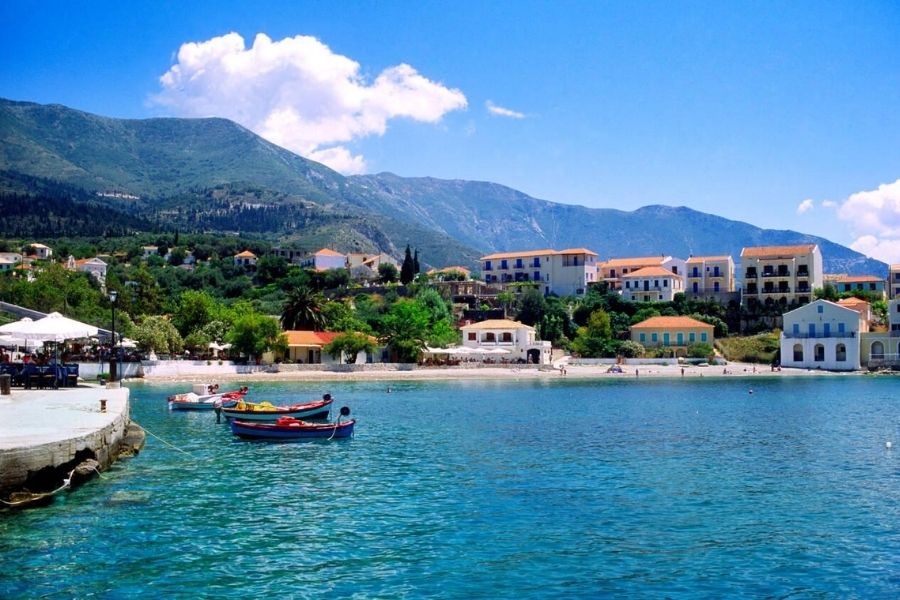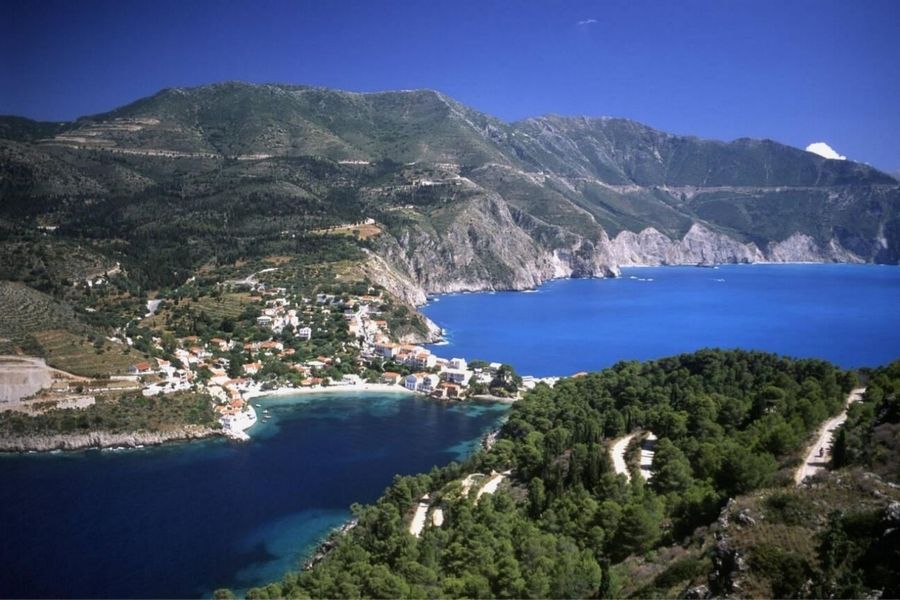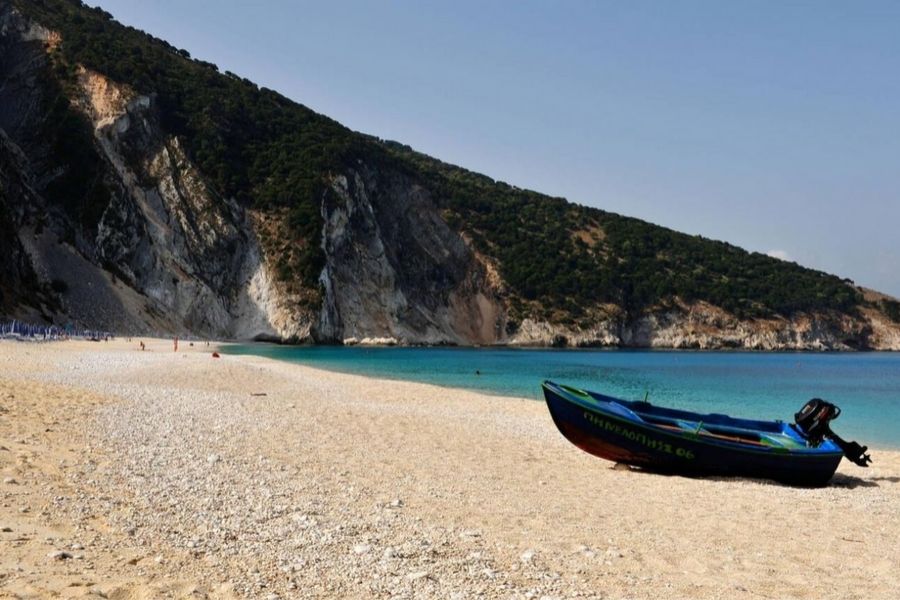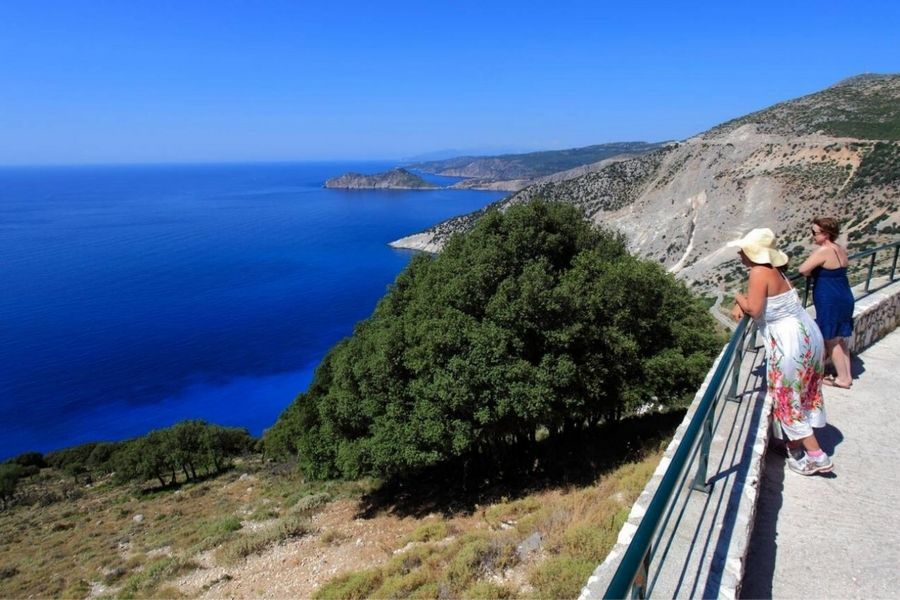The rugged cliffs of Kefalonia shoot up from turquoise waters, and honestly, I felt like I’d stepped into a dream when I first set foot on this Greek island. No wonder Hollywood picked it for one of cinema’s most swoon-worthy war stories.
Captain Corelli’s Mandolin, filmed here in 2001, catapulted Kefalonia from a hidden gem to international fame. Suddenly, places like Myrtos Beach and Antisamos weren’t just for locals—they became must-sees for movie buffs and nature lovers.
But what really caught my heart? It wasn’t just the connection to Nicolas Cage and Penélope Cruz’s romance on screen. The real stories—the wartime past, the resilience of the people—set the stage for a love story that feels almost too big for fiction.
I wandered through villages where locals once played extras, and I stood on those beaches where dramatic scenes played out. The movie, honestly, just scratches the surface of what makes this place so magnetic.

You’ll find traces of the film everywhere—Myrtos Beach, where the mine exploded on screen, and rebuilt village sets near Sami. If you’re into cinematic history, Kefalonia lets you step right into it.
But here’s the thing: the island’s wild landscapes, deep-rooted culture, and powerful history will keep you hooked long after the movie fades from memory.
Kefalonia’s Cinematic Legacy: The Impact of Captain Corelli’s Mandolin
Back in 2001, the film totally changed how people saw Kefalonia. Director John Madden’s adaptation brought Hollywood stars and a tidal wave of attention to places that, until then, tourists mostly skipped.
How the Film Put Kefalonia on the Map
Before Captain Corelli’s Mandolin, Kefalonia was just this quiet island floating in the Ionian Sea. Most travelers headed to Santorini or Mykonos instead.
When the movie came out, everything changed. Tourism exploded.

People started arriving just to see where Nicolas Cage and Penelope Cruz acted out their love story. The island jumped from obscurity to must-see destination almost overnight.
Key filming locations turned into instant attractions:
- Sami harbor became a war-torn port
- Antisamos Beach set the scene for dramatic moments
- Myrtos Beach stunned with its coastal views during battle sequences
Locals didn’t waste any time. Tour operators rolled out “Captain Corelli” excursions. Hotels and tavernas started offering themed menus and displaying movie memorabilia.
The buzz didn’t fade quickly. Even now, more than twenty years later, fans still flock to these spots. The film gave Kefalonia a permanent place on the global travel map.
Behind the Scenes: John Madden’s Vision
John Madden, fresh off Shakespeare in Love, picked Kefalonia for its real World War II vibe. The island’s traditional architecture and untouched scenery matched the novel’s tone perfectly.
He needed places that could pass for 1940s Greece. Kefalonia delivered with its timeless villages, rugged coasts, and buildings that seemed frozen in time.
Locals got involved, too. Many became extras or helped the crew with logistics. Their input kept the film’s atmosphere authentic.
Production wasn’t easy:
- They had to make modern spots look like the 1940s
- Managing a big international crew on a small island got tricky
- Coordinating with local authorities and businesses took patience
Madden’s eye for detail paid off. He used Kefalonia’s natural light and unpredictable weather to add emotional punch to the story.
The Role of Nicolas Cage and Penelope Cruz in Reviving History
Nicolas Cage played Captain Antonio Corelli, the Italian officer at the heart of the story. His mandolin and charm gave Kefalonia’s wartime history a romantic twist for viewers everywhere.
Penelope Cruz took on Pelagia, the Greek woman torn between love and loyalty. Their chemistry, set against Kefalonia’s jaw-dropping scenery, created moments that still draw visitors.

Picking these actors mattered for the island’s future. Both were at the top of their game in 2001, so every filming location got global attention.
Their scenes showed off Kefalonia’s beauty:
- Romantic strolls along Antisamos Beach
- Quiet talks in traditional villages
- Heart-wrenching moments on the rugged coastline
Sure, some critics nitpicked the historical details. But their performances made Kefalonia’s landscapes unforgettable. They turned real places into cinematic icons that still attract film fans.
Iconic Filming Locations Across the Island
The film turned several Kefalonia spots into movie magic. Sami became the main village backdrop, while beaches like Antisamos and Chorgota showed off the Mediterranean’s turquoise waters.
Sami: From Reel to Real
Sami ended up at the center of Captain Corelli’s Mandolin. The main square got a makeover to look like Argostoli, with fake street signs painted right onto the walls.
Cobbled streets and old buildings around the square hosted key scenes. Italian soldiers danced with locals during evening celebrations. The port captured the arrival of the troops.
Key Sami spots:
- Town square (market and dancing)
- Narrow streets (daily life)
- Harbor (military arrival)
- Hills and olive groves nearby
I found the square just a short walk from the port. Many buildings from the film are still there, though the props have long since vanished.
Antisamos and Horgota: Beaches of Turquoise Waters
Antisamos Beach became the Italian army’s main camp on screen. I could imagine the rows of military tents stretching along the white pebbles.
The beach sits a few kilometers from Sami—now there’s a paved road, but back then it was just a dirt track. The Ionian Sea’s turquoise shimmer made it the perfect spot for scenes of soldiers’ daily routines.

Chorgota Beach got its moment as “Pelagia Beach.” This little bay hosted the romantic swim between Pelagia and Mandras. The crew built a small pier just for the movie.
Beach filming highlights:
| Beach | Scene Type | Current Access |
|---|---|---|
| Antisamos | Military camp | Easy by car |
| Chorgota | Romance scenes | Narrow mountain road |
The pier at Chorgota has vanished, battered by storms, but both beaches are still gorgeous for swimming.
Fiscardo: The Timeless Fishing Village
Fiscardo didn’t get much screen time, but it’s the kind of place that drew filmmakers to Kefalonia in the first place. This northern village survived the 1953 earthquake that wrecked most of the island.
I wandered past Venetian buildings and colorful waterfront houses that look almost untouched. Traditional fishing boats bob in the harbor, and tavernas spill out onto the quay.
Fiscardo shows off the timeless charm that made Kefalonia perfect for a period film. Pastel houses, cypress hills, and that laid-back harbor vibe—it’s all here.
If you want a glimpse of pre-war island life, this is it.
Dramatic Beauty: Exploring Kefalonia’s Natural Wonders
Kefalonia’s landscape is a wild mix—towering limestone cliffs, turquoise coves, rolling hills covered in olive trees, and secret beaches you’ll only find if you’re up for a little adventure.
The island feels like nature’s playground, full of contrasts and hidden gems.
Myrtos Beach: Cinematic Cliffs and Crystal Seas
Standing at the viewpoint above Myrtos Beach, I finally got it—why filmmakers fell for this spot. The beach curves between two massive cliffs that drop straight into the Ionian Sea.
White marble pebbles line the shore, shining against the deep blue water. These stones aren’t just pretty—they’re smooth marble, polished by centuries of waves.

Swimming here isn’t for the faint-hearted. The drop-off is steep and the currents can get rough. But if you stick around for sunset, you’ll see why this place is legendary.
Key Features:
- White marble pebbles
- 200-meter limestone cliffs
- Crystal-clear turquoise water
- Famous filming location
Myrtos Beach keeps popping up on lists of the world’s best beaches. The cliffs create a natural amphitheater, and the waves echo off the rocks.
Lush Countryside and Rolling Hills
Mount Ainos rises up in the middle of Kefalonia, topping out at 1,628 meters. It’s the highest peak in the Ionian Islands and home to the rare Kefalonian fir—nowhere else on Earth has it.
I hiked through Ainos National Park and stumbled across all kinds of landscapes. One minute you’re in dense forest, the next you’re in a wildflower-filled meadow.
Villages like Assos tuck into the hills, surrounded by olive groves and vineyards. The Robola wine region sprawls across the slopes, and the white wine is worth a try.
Stone walls crisscross the countryside, dividing old plots. Wild herbs like oregano and thyme grow everywhere. The terrain shifts from scrubby near the sea to cool forests up high.
Hidden Gems Off the Beaten Path
Melissani Cave hides an underground lake that glows turquoise when sunlight hits. I hopped in a little boat and drifted across the clear water, hearing stories about nymphs and ancient myths.
Near Argostoli, the Katavothres phenomenon puzzled scientists for ages. Seawater vanishes into sinkholes and pops up again at Melissani Cave, miles away.
Other natural wonders worth finding:
- Drogarati Cave and its eerie stalactites
- Antisamos Beach’s pebble shore
- Fteri Beach—only reachable by boat or on foot
- Natural rock pools near Skala
Getting to these places takes some effort, but the reward? Wild, untouched beauty and hardly any crowds.
History and Resilience: Kefalonia’s Wartime Past
Kefalonia faced its darkest days during World War II. Italian forces occupied the island, and then German retaliation led to thousands of deaths. Today, memorials honor the Italian soldiers who died, and the island’s wartime story still echoes through books and film.
The Italian Occupation During World War II
In 1941, Italian troops rolled into Kefalonia as part of Mussolini’s push into Greece. The occupation brought a strange mix of military order and everyday island life.
The Acqui Division set up across the island. Some Italian soldiers actually bonded with Greek families. I heard stories of them sharing rations with hungry kids and building real friendships with locals.
Everything flipped upside down in September 1943 when Italy switched sides to the Allies. German troops demanded the Italians hand over their weapons and join them. The Italians refused.
What followed was brutal—ten days of fighting, with the Germans eventually overpowering the Italians.

The aftermath was horrifying. About 9,500 Italian soldiers lost their lives. Roughly 1,200 died in battle, but the real tragedy? Around 5,000 were executed after surrendering.
German troops hunted down survivors, killing them in cold blood. They shot officers in groups, then threw their bodies into the sea, weighed down with barbed wire.
Memorials of the Acqui Division
In Argostoli, Kefalonia’s capital, a memorial stands to honor the massacre victims. Italian families still come here, treating it almost like a pilgrimage site to remember their ancestors.
The Museum of the Acqui Division keeps the history of these tragic events alive. Volunteers—often family members of survivors—share stories with visitors, making sure the memories don’t fade away.
I’ve noticed that Italian-Greek connections forged during the war still linger. Some Greek families hid Italian soldiers from German patrols, risking everything. Those moments of courage sparked friendships that somehow managed to last through generations.
Maria Assunta Giotto Pellegrini’s story always sticks with me. In 2001, she made her way to Kefalonia, hoping to find the Matiatos family who once helped her father escape. The Greek family never forgot her father’s kindness—especially when he shared what little food he had with their hungry children.
Mediterraneo, a Greco-Italian association, now works to preserve these old wartime bonds. They help run the museum and set up events to honor both the Italian soldiers and the Greek families who risked everything to help them.
Echoes of History in Modern Kefalonia
When Louis de Bernières wrote Captain Corelli’s Mandolin in 1994, he brought Kefalonia’s wartime story to millions. The novel follows Captain Antonio Corelli, an Italian officer who falls for a local doctor’s daughter.
Yes, the book romanticized a lot, but it also introduced the world to Kefalonia’s real, painful history. The 2001 film starring Nicolas Cage and Penélope Cruz was actually filmed on the island.
These days, Italians still come to Kefalonia because of this shared past—some even end up staying for good. That connection between Italian and Greek cultures feels alive, almost tangible, when you visit.

Strolling through Argostoli, I kept hearing Italian mixed with Greek. Many restaurants offer menus in both languages. It’s clear that those old wartime ties have turned into something new—a blend of cultures that gives the island a unique vibe.
Experiencing ‘That Famous Mandolin’: Walking in the Film’s Footsteps
Captain Corelli’s Mandolin left its mark on Kefalonia. You can actually visit the beaches, villages, and little corners where the movie brought this wartime romance to life.
Visiting Filming Sites and Local Landmarks
Sami became the heart of my Captain Corelli’s Mandolin journey. This small eastern town was the main filming location, and I wandered the same streets where Nicolas Cage’s character once charmed the locals.
The main square by the port hasn’t changed much since the movie days. Sure, some facades were built just for filming and later taken down, but the atmosphere that drew filmmakers here still lingers.
Antisamos Beach is probably the most recognizable spot. I stood on the same pebbles, looking out at those crystal-clear waters and lush hillsides from the film. In the movie, this was the Italian soldiers’ camp.
What really surprised me was how untouched it felt. No sunbeds, no beach bars—just the same natural beauty you see on screen.
Myrtos Beach shows up in some of the most dramatic scenes. I recognized the clifftop views where Italian soldiers sang together. The bomb explosion scene happened here too, though thankfully, the beach itself hasn’t changed.
Guided Tours and Self-Discovery Routes
I tried both guided tours and just exploring on my own. Local tour operators in Sami run Captain Corelli’s Mandolin-themed trips, visiting all the major sites.
These tours usually include transport and some great insider stories about the filming. Guides point out exactly where certain scenes were shot and share how the production affected the local community.
If you prefer to go solo, renting a car works well. I started in Sami for the village scenes, then drove to Antisamos Beach—it’s only a few minutes away. Myrtos Beach is a bit farther but absolutely worth the drive for those views.
Old Vlachata is a cool stop if you love history. This little village near Sami had many of the period-style buildings used in the movie. Some of the movie facades stuck around for years after filming.

Over on the northeast coast, the small bay of Chorgota played host to scenes with Penélope Cruz and Christian Bale. The pier built for the film is long gone, but the bay itself still feels cinematic.
Frequently Asked Questions
People often ask about the movie’s filming locations, how true the story is, and where to watch or read the story. The film used several of Kefalonia’s beaches and villages, while the story itself is rooted in real World War II events.
What are the main locations in Kefalonia featured in Captain Corelli’s Mandolin?
Sami was the primary filming spot. Filmmakers transformed its streets and main square to create the iconic Greek village.
Antisamos Beach became the Italian army’s camp in the movie. This beautiful beach sits just a short drive from Sami.
Myrtos Beach appears in scenes where Italian soldiers sing and have fun. That dramatic white pebble beach is hard to miss.
Chorgota Beach is where Mandras goes fishing and swims with Pelagia. The movie’s small pier is gone, but you can still visit the spot.
Dikhalia was the area chosen for Pelagia’s family home. The movie sets built there were taken down after filming.
Is the story depicted in Captain Corelli’s Mandolin based on historical events?
The novel draws heavily from real World War II events on Kefalonia. Italian forces did occupy the island, just as in the story.
The Italian Acqui Division actually stationed themselves on Kefalonia. Their conflict with German troops after Italy surrendered is based on true events.
The love story between Pelagia and Captain Corelli? That’s fiction. Still, Louis de Bernières grounded the setting and the war’s events in solid historical research.
Can I find Captain Corelli’s Mandolin available for streaming on platforms like Netflix?
Streaming options change all the time. I usually check Netflix, Amazon Prime, or whatever’s available locally.
Depending on where you are, the movie might pop up on different services. These platforms rotate their selections a lot.
If you can’t find it online, local libraries often have DVDs you can borrow. Sometimes, old-school is the way to go.
Where can I find a PDF of the Captain Corelli’s Mandolin wedding reading?
The wedding reading comes from the novel’s chapter about love. Lots of couples use Dr. Iannis’s letter to Pelagia for their ceremonies.
Wedding websites often post excerpts from the book. Try searching “Captain Corelli wedding reading” and you’ll probably find it.
For the full passage, check out Louis de Bernières’s original novel at your library or a bookstore.
Who were the lead actors in the film adaptation of Captain Corelli’s Mandolin?
Nicolas Cage starred as Captain Antonio Corelli in the 2001 movie. Penélope Cruz played Pelagia, the Greek woman who falls for him.
Christian Bale took on the role of Mandras, Pelagia’s Greek fiancé. John Hurt played Dr. Iannis, Pelagia’s father.
John Madden directed the film. He also directed Shakespeare in Love before taking on this project.
How does the narrative of Captain Corelli’s Mandolin conclude in the novel?
The story stretches over decades after the war wraps up. Eventually, Corelli comes back to Kefalonia, but he’s much older by then.
Pelagia and Corelli finally see each other again after all those years. Their love, somehow, circles back around, even though so much time has slipped by.
Honestly, the ending isn’t quite like what you see in the movie. The novel digs deeper, exploring the lasting impact of war and the relentless march of time.

